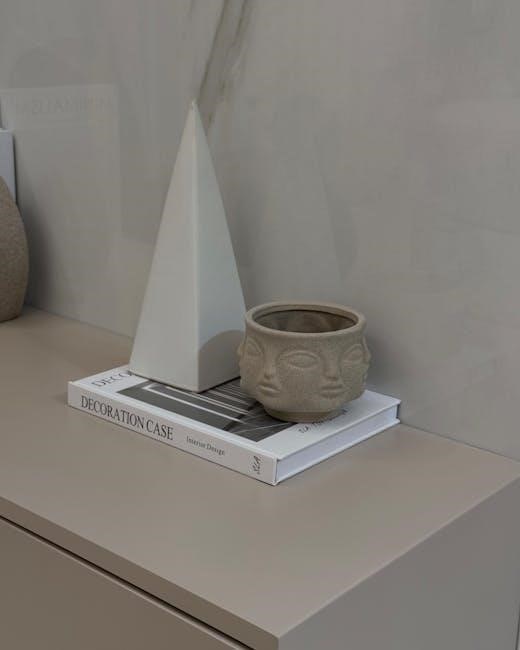Overview of “The Art of Living” Book
“The Art of Living” encompasses various books, often available in PDF format, exploring themes of mindfulness, simple living, and financial wisdom. These resources offer guidance on meditation, breathwork, and ethical living, impacting focus and well-being.
Different books with the same name
The title “The Art of Living” has been used by multiple authors, leading to a diverse range of books exploring the concept. These books, often found in PDF format, cover various aspects of life, from financial management and simple living to spiritual practices like Vipassana meditation. Authors like Robert Grant and Andre Maurois have offered their unique perspectives under this title, resulting in distinct works with differing focuses. This necessitates careful attention to the author when searching for a specific “Art of Living” PDF.

Authors of “The Art of Living”
Several authors have penned books titled “The Art of Living,” each offering unique perspectives. Robert Grant and Andre Maurois are two notable examples. Their works, often accessible as PDFs, explore different facets of life.
Robert Grant’s “The Art of Living”
Robert Grant’s “The Art of Living,” sometimes available as a free PDF, delves into practical aspects of daily life. It covers income management, housing, education, and the effective use of time. Grant contrasts characters who live modestly with those consumed by societal pressures to display wealth. The book also teaches the art of budgeting. It also emphasizes living well on a limited income, as taught to the narrator by a friend’s bookkeeper, Mr. Rogers.
Andre Maurois’ “The Art of Living”
Andre Maurois’ “The Art of Living,” accessible through sources like the Digital Library of India, presents reflections on various aspects of existence. This book, sometimes available as a PDF download, explores themes related to personal fulfillment and navigating the complexities of modern life. Maurois offers insights into cultivating a balanced and meaningful existence, emphasizing intellectual and emotional well-being. The book’s availability through digital archives allows for broader access to Maurois’ perspectives. It provides timeless wisdom that readers can apply to their own lives.

Core Concepts Discussed
Central concepts often revolve around simple living, mindfulness practices such as Vipassana meditation, and techniques for developing inner peace. Emphasis is placed on daily practices and ethical conduct to enhance well-being.
Simple Living and Mindfulness
“The Art of Living,” often explored through readily available PDF resources, emphasizes simple living as a path to contentment. It advocates for reducing unnecessary complexities in life, focusing on the present moment through mindfulness. This involves cultivating awareness of one’s thoughts, feelings, and surroundings without judgment. By embracing simplicity and practicing mindfulness, individuals can experience greater peace, reduce stress, and enhance their overall well-being, as detailed in various downloadable texts and guides.
Vipassana Meditation and its Role
Vipassana meditation, a core element in “The Art of Living,” plays a crucial role in self-transformation. PDF resources often detail its practice and benefits. This technique, taught by figures like S.N. Goenka, involves observing the breath and bodily sensations to develop mindfulness and equanimity. Vipassana helps practitioners gain insight into the nature of reality, reduce suffering, and cultivate inner peace. It’s presented as a practical method for daily living, promoting focus, emotional balance, and a deeper understanding of oneself, with numerous texts available for free download.
Availability of PDF Versions
Many versions of “The Art of Living” are available as PDF downloads. These digital copies offer convenient access to the book’s content, often found for free on various online platforms and digital libraries.
Free PDF Downloads from Various Sources
Numerous websites offer free PDF downloads of “The Art of Living,” spanning different authors and editions. Readers can find versions focusing on Vipassana meditation, financial budgeting, and philosophical explorations of ethics and virtue. Be cautious of copyright and legitimacy when downloading. These sources include online archives, project repositories, and platforms dedicated to sharing public domain works. Always verify the source’s credibility before downloading to ensure the file is safe and authentic. Enjoy the accessibility these digital versions provide!
Digital Library of India Offerings
The Digital Library of India provides access to digitized versions of “The Art of Living” by authors like Andre Maurois. These offerings include PDF downloads, sometimes with searchable text, enhancing accessibility. These versions allow readers to explore the book’s themes of ethics, virtue, and the human spirit. The library’s collection provides a valuable resource for accessing older editions. Ensure proper attribution when using these resources. Explore the Digital Library of India to discover a wealth of literature. Remember to check the usage rights associated with each item.
Key Themes Explored
“The Art of Living” books delve into financial wisdom, budgeting, ethics, and virtue. They aim to cultivate the human spirit, promoting mindfulness and a balanced approach to life’s challenges.
Financial Wisdom and Budgeting
Some editions of “The Art of Living,” particularly Robert Grant’s, emphasize financial prudence. These books teach the art of living well on a limited income, advocating for modest living over societal pressures to display wealth. Characters like Mr. Rogers are presented as examples of financial wisdom, demonstrating effective budgeting techniques. The core message highlights the importance of managing resources wisely to achieve a fulfilling life, regardless of financial limitations. These principles provide practical guidance for individuals seeking financial stability and contentment.
Ethics, Virtue, and the Human Spirit
Dietrich von Hildebrand’s version of “The Art of Living” delves into the realm of ethics, virtue, and the human spirit, exploring the quest for a meaningful life. This exploration examines the fundamental building blocks of life and society. It is a profound discussion of the timeless search for a life well-lived, drawing on his deep understanding of these principles. The book encourages readers to cultivate virtues and ethical behavior to enrich their lives and contribute positively to the world around them, fostering a deeper connection with their inner selves.

Practical Applications
The teachings found within “The Art of Living” books translate into practical techniques such as breathwork, meditation, and mantra chanting. They also emphasize developing daily mindfulness practices to enhance well-being and focus.
Breathwork, Meditation, and Mantras
Within “The Art of Living” literature, breathwork, meditation, and mantras are presented as central tools for inner peace and self-discovery; The books often provide practical guidance on incorporating these techniques into daily life, offering specific exercises and routines. Breathwork practices, such as those taught in some Art of Living courses, aim to sharpen focus and reduce stress. Meditation, particularly Vipassana, is highlighted for its role in developing mindfulness. Mantras, or chants, are suggested to calm the mind. Regular application of these can improve overall well-being.
Developing a Daily Practice
“The Art of Living” resources emphasize the significance of establishing a consistent daily practice for lasting positive change. These books and teachings encourage readers to integrate mindfulness, meditation, and ethical considerations into their daily routines. Starting small and gradually incorporating new habits is often recommended. Creating a dedicated time and space for practice is also suggested to foster consistency. The importance of self-compassion is highlighted, acknowledging that setbacks are normal. By diligently developing and maintaining a daily practice, individuals can cultivate inner peace, focus, and improved well-being.

Influence and Impact
“The Art of Living” principles, often accessed via PDF books, have demonstrably influenced diverse communities by promoting focus, well-being, and ethical conduct. Vipassana meditation, a core element, plays a key role in this positive transformation.
Vipassana’s Impact in Diverse Communities
Vipassana meditation, often learned through resources like “The Art of Living” PDF books, demonstrates significant impact across diverse communities globally. By offering a practical approach to mindfulness, it transcends cultural and religious boundaries, fostering inner peace and improved focus. Individuals from various backgrounds report enhanced well-being, stress reduction, and a greater sense of interconnectedness. The accessibility of introductory materials, particularly in digital formats, contributes to its widespread adoption and transformative influence on individuals and communities alike, promoting ethical living and personal growth. This ancient technique continues to resonate in modern society.
Positive Effects on Focus and Well-being
“The Art of Living,” often accessed through PDF resources, highlights techniques like breathwork and meditation that yield notable positive effects on focus and well-being. Consistent practice of these methods enhances concentration, reduces stress, and promotes emotional balance. Individuals report improved clarity, increased productivity, and a greater sense of overall happiness. The principles outlined in such materials encourage a mindful approach to daily life, fostering resilience and a deeper connection with oneself. By integrating these practices, individuals experience enhanced mental clarity, reduced anxiety, and a more profound sense of well-being.
